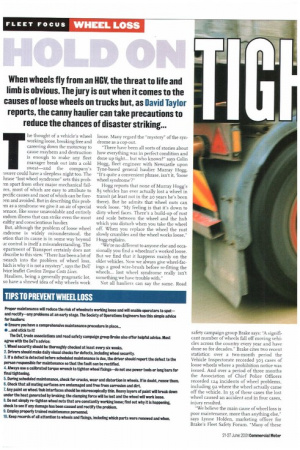TIPS TO PREVENT WHEEL LOSS
Page 34

If you've noticed an error in this article please click here to report it so we can fix it.
Proper maintenance will reduce the risk of wheelnuts working loose and will enable operators to spot— and rectify—any problems at an early stage. The Society of Operations Engineers has this simple advice for hauliers: • Ensure you have a comprehensive maintenance procedure in place...
• ...and stick to it!
The DoT, trade associations and road safety campaign group Brake also offer helpful advice. Most agree with the DoT's advice: 1. Wheel security should be thoroughly checked at least every six weeks.
2. Drivers should make daily visual checks for defects, including wheel security.
3. If a defect is detected before scheduled maintenance is due, the driver should report the defect to the person responsible for maintenance so that the fault can be rectified.
4. Always use a calibrated torque wrench to tighten wheel fixings—do not use power tools or long bars for final tightening.
5. During scheduled maintenance, check for cracks, wear and distortion in wheels. If in doubt, renew them.
6. Check that all mating surfaces are undamaged and free from corrosion and dirt.
7. Any paint on wheel/hub interfaces should be microscopically thin. Heavy layers of paint will break down under the heat generated by braking; the clamping force will be lost and the wheel will work loose. R. Do not simply re-tighten wheel nuts that are constantly working loose; find out why it is happening, check to see If any damage has been caused and rectify the problem.
9. Employ properly trained maintenance personnel.
10. Keep records of all attention to wheels and fixings, including which parts were renewed and when.
































































































